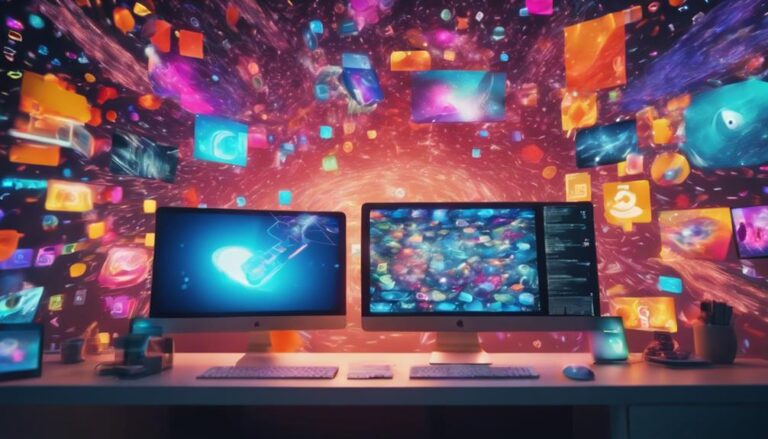2D Animation Design Principles for Beginners
You're about to reveal the secrets of mesmerizing 2D animation, where deliberate design principles bring characters to life, guide the viewer's attention, and tell a story that resonates. To get started, focus on creating a clear visual hierarchy, balancing composition elements, and developing emotional connections with your characters. This will help you craft a narrative that engages and holds your viewer's attention. By mastering these fundamental principles, you'll be well on your way to designing animations that truly pop. Now, explore how to visualize your story, create relatable characters, and guide the viewer's eye through your scene, and discover the magic of 2D animation design.
Key Takeaways
- A deliberate visual hierarchy guides the viewer's attention to the most important elements, creating a clear narrative and engaging storyline.
- Balance and harmony are achieved by strategically placing focal points, using visual weight, and arranging composition elements to draw the viewer's eye.
- Developing character empathy through relatable traits, emotions, and imperfections makes characters memorable and invests the audience in the story.
- Storyboarding helps visualize the story sequence, defines shot composition, and creates a cohesive and engaging storyline by balancing pacing and scene progression.
- A clear visual flow is crafted by intentionally guiding the viewer's eye through the scene, using visual cues, contrast, and spatial grouping to focus attention.
Understanding Visual Hierarchy
When creating a 2D animation, you need to guide the viewer's attention through a deliberate visual hierarchy, as it helps to focus their attention on the most important elements and create a clear narrative.
This hierarchy is vital in directing the viewer's eye to the key areas of your animation.
To achieve this, you'll want to create focal points that draw the viewer's attention. These focal points can be created using visual weight, which refers to the amount of attention an element receives based on its size, color, and placement.
You can create visual weight by using larger or brighter elements, or by placing them in areas where the viewer's eye naturally falls.
By strategically placing these focal points, you can control the flow of the viewer's attention and create a clear narrative.
Remember, a well-planned visual hierarchy will help your animation tell a story that engages and holds the viewer's attention.
Balancing Composition Elements
By deliberately balancing composition elements, you create a visually appealing and harmonious arrangement that complements your visual hierarchy, drawing the viewer's eye to the key areas of your animation.
This balance is essential to maintaining visual interest and guiding the viewer's attention.
To achieve visual balance, you'll need to weigh the symmetry aspects of your composition. Symmetry can be achieved through the use of identical elements on either side of a central axis, but it can also be achieved through the use of asymmetrical elements that balance each other out.
For instance, a large shape on one side of the composition can be balanced by a smaller shape on the other side, as long as the visual weight of the two elements is equal.
By balancing composition elements, you'll create a sense of harmony and stability in your animation, which will engage your viewers and keep them interested.
Creating Emotional Connections
How do you evoke emotions in your audience, making them invested in your animation's narrative and characters?
It all starts with creating emotional resonance. You want your audience to connect with your characters on a deeper level, feeling what they feel and empathizing with their struggles.
To achieve this, focus on developing character empathy. Make your characters relatable, giving them universal desires, hopes, and fears that resonate with your audience.
Use body language, facial expressions, and voice acting to bring your characters to life. Show their vulnerabilities and imperfections, making them more human and authentic.
This will help your audience form an emotional bond with your characters, investing them in the story. Remember, emotional connections are key to a memorable and impactful animation.
Developing Character Personality
You'll bring your characters to life by crafting unique personalities that shine through their actions, dialogue, and interactions. This is where your characters' quirks, flaws, and strengths will make them relatable and lovable.
To develop your character's personality, focus on the following key aspects:
Character traits: Define your character's values, fears, and motivations. What drives them? What do they want to achieve?
Facial expressions: A character's facial expressions can convey their emotions and personality. Think about how your character's face will change when they're happy, sad, or angry.
Body language: How does your character move and react physically? Do they slouch or stand tall? Do they fidget or remain still?
Quirks and habits: Give your character unique quirks and habits that make them stand out. For example, do they have a nervous habit of tapping their foot or twirling their hair?
Mastering Storyboard Fundamentals
You'll learn how to break down your story into a clear sequence, visualize the structure of each scene, and define the perfect shot composition to bring your animation to life.
Understanding Story Sequence
By grasping the concept of story sequence, you'll be able to visualize and organize your narrative's pacing, tone, and emotional flow. A well-planned story sequence helps you create a cohesive and engaging storyline. Understanding how to structure your scenes is crucial to keep your audience invested in your story.
Some key aspects to ponder when planning your story sequence:
Scene progression: Each scene should build upon the previous one, creating a sense of continuity and flow.
Pacing strategy: Balance action, dialogue, and quiet moments to keep your audience engaged.
Character development: Use scenes to reveal character traits, motivations, and emotions.
Plot twists and turns: Use unexpected events to add surprise and tension to your story.
Visualizing Scene Structure
As you plunge into visualizing your scene structure, remember that a well-crafted storyboard is essential to bringing your story to life.
You're not just organizing shots; you're creating a visual blueprint that guides your entire production.
Start by blocking out your scene geography, considering the physical space where your characters will interact.
This will help you determine the flow of action and the placement of key elements.
Next, think about camera angles and how they can enhance the mood and drama of your scene.
Will you use a wide shot to establish the setting, or a close-up to highlight a character's emotions?
How will you shift between shots to create a seamless flow?
Remember, your camera angles should serve the story, not the other way around.
By carefully planning your scene structure, you'll be able to visualize the pacing, tension, and emotional resonance of your scene, ensuring that your animation is engaging and effective.
With a solid scene structure in place, you'll be well on your way to crafting a compelling and memorable story.
Defining Shot Composition
When crafting your shot composition, you'll want to carefully balance negative space, character placement, and visual elements to create a harmonious and engaging visual narrative. This balance will guide the viewer's attention and create a sense of flow throughout the scene.
Experiment with different camera angles to add visual interest and convey the mood of the scene. From high-angle shots to low-angle shots, each angle can evoke a unique emotional response.
Make sure to ponder the frame aspect ratio when composing your shot. A 16:9 ratio can create a more cinematic feel, while a 4:3 ratio can be more suitable for a classic, retro look.
Place your characters thoughtfully within the frame, taking into account their relationship to each other and the environment. This will help create a sense of depth and context.
Organize visual elements within the frame to create a clear visual hierarchy. This will help guide the viewer's attention and create a sense of balance.
Designing for Visual Flow
As you design your 2D animation, you're not just creating individual elements – you're crafting a visual journey for your viewer.
You'll want to intentionally guide their eye through the scene, using visual cues to focus their attention on what's important.
Guiding the Viewer's Eye
You can deliberately guide the viewer's eye through your animation by carefully arranging visual elements to create a clear flow of attention. This is vital in 2D animation design, as it helps the audience focus on the most important parts of the scene.
To achieve this, you can use various techniques to create focal points and visual cues that direct the viewer's eye.
Use contrasting colors: Bright colors or high-contrast elements can draw the viewer's attention to a specific area.
Create visual paths: Lines, shapes, or patterns can lead the viewer's eye to a particular focal point.
Employ framing techniques: Use frames, arches, or other shapes to create a visual boundary around important elements.
Add motion and animation: Movement can grab the viewer's attention and guide their eye to a specific part of the scene.
Creating Visual Hierarchy
To create an effective visual flow, organize your design elements into a clear visual hierarchy, prioritizing the most important information and guiding the viewer's eye through the scene.
This means arranging elements in order of importance, so the viewer's attention is drawn to the most critical parts of the design. You can achieve this by using visual contrast, such as size, color, and texture, to create a clear distinction between elements. For instance, use a bold font to highlight key text or a bright color to draw attention to a call-to-action.
Another technique is spatial grouping, where you group related elements together to create a clear visual connection. This helps the viewer quickly understand the relationships between elements and navigate the design more easily.
Frequently Asked Questions
How Do I Stay Inspired and Avoid Creative Burnout?
To avoid creative burnout, you take care of your mental wellness practices, like meditation and journaling, and make time for creative breaks, like sketching or reading, to recharge and refocus your artistic energy.
What Software or Tools Are Best for Beginners?
You'll find plenty of free Blender tutorials online, and as a beginner, it's a great place to start. If you're looking for Autodesk alternatives, consider SketchUp or Tinkercad – both are user-friendly and offer a gentle learning curve.
Can I Use 2D Skills in 3D Animation Design?
You're wondering if your 2D skills can translate to 3D animation design? Absolutely! Your existing skillset is adaptable, and with practice, you'll find the 2D to 3D shift smoother than you think, allowing you to expand your creative horizons.
How Long Does It Take to Become Proficient in 3D Design?
You're wondering how long it takes to become proficient in 3D design? With daily practice, you'll see progress in a few weeks, but consistency matters – stick to it for 3-6 months to develop solid skills.
Are There Any Free Online Resources for Learning 3D Design?
You're in luck! You'll find plenty of free online resources to learn 3D design, including online tutorials and YouTube channels like Blender Guru, CG Academy, and Tuts+, offering step-by-step guides and expert tutorials to get you started.
Conclusion
You've made it to the end of our 2D animation design principles crash course!
Now, take these fundamental skills and run with them. Remember, visual hierarchy, composition, emotional connections, character personality, storyboarding, and visual flow are the building blocks of mesmerizing animation.
Practice, experiment, and have fun with them. As you continue to hone your craft, you'll bring your unique vision to life and leave a lasting impression on your audience.
The world of 2D animation awaits – go create!






